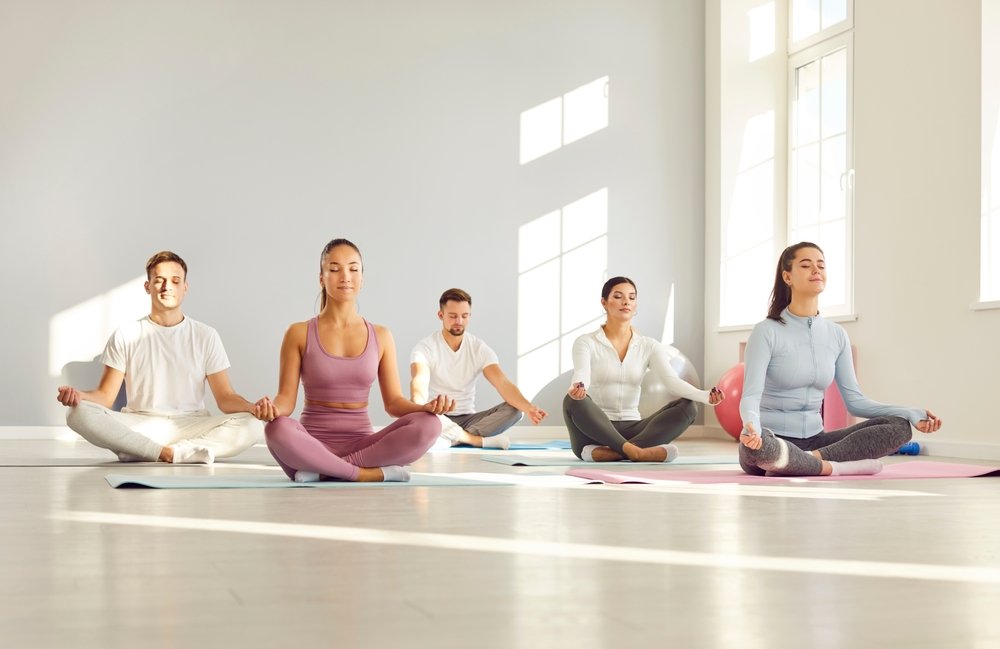The brief history of yoga before going into the objectives of yoga. The ancient Indus Saraswati Valley civilization thousands of years ago before the first religion and belief was born. Meditation techniques combined with ancient wisdom from the core of yoga. Yoga can improve health and wellness for individuals by making them flexible and balanced people can improve their fitness by daily asanas [yoga, poses] and pranayama.
- Practice mental health
Mental health is a critical aspect of overall well-being and yoga education Regular practice of these techniques reduces stress, improves concentration, and fosters a positive mindset. meditation, pranayama, and mindfulness practice are to yoga education.
- That’s Promotes Mental Clarity and Emotional Balance
Yoga is a powerful tool for mental health. Mental health is a critical aspect of the overall well-being yoga education maintaining and enhancing. Practicing mindfulness through yoga sessions brings attention to the present, leading to enhanced concentration and emotional stability.
- Stimulating Healthy Choices
By practicing yoga, one is typically inspired to lead a better lifestyle. Research conducted in India illustrates that yoga practitioners have been found to consume different health diets, engage in physical activity, and opt for activities that promote wellness in their leisure time. This approach to yoga is holistic in nature and cuts beyond the traditional practices of yoga, impacting other habits of daily living towards the quality of life.
- Development of spirituality
Yoga is important for creative and mental development. While Bhakti-Yoga cultivates a sense of devotion leading to a feeling of intimate bonding with oneself and the rest of the world, this spiritual side of yoga, in turn, paves the way toward one purpose and peace of mind.
- Community and Social Bonding
Yoga attracts individuals to come together to form communities based on health and mindfulness. Whether in group classes or retreats, these opportunities provide space for social interaction, support, and collective growth, which admittedly benefit social well-being.
- Promoting Sustainable Living
The principles of yoga demand respect for all living forms and ecology. This ethos blends well with sustainable living practices, directing toward eco-beneficial choices and balance with nature.
- Physical Health and Fitness
Among the most immediate and concrete aims of yoga is improving physical health. The practice of yoga through postures (asanas) and breathing techniques (pranayama) can achieve the following.
Flexibility and Strength: If done regularly, they will stretch and strengthen the muscles and keep the body more flexible and physiologically resistant.
- Spiritual Curiosity
Improvement in posture and alignment: Yoga encourages better body alignment that will lessen chronic pain and avert injuries in the long term.
- Physical Education – Study Material
The main goals of yoga are, basically, physical well-being and energy. Asanas are the postures. They improve flexibility, balance, strength, and endurance. Each is meant to work some part of the body’s muscles, organs, and systems. For instance, the forward bends have great effects on digestion, the back bends open up the chest and lung, and inversions improve circulation of the blood. Apart from physical benefits, yoga helps cope with stress-related diseases such as hypertension, diabetes, and insomnia. Yoga concentrates on mindful movement; each action is informed with aware thought and intention to build a deeper bond between the body and mind.
Types of Yoga
ASHTANGA YOGA: yoga practice uses ancient yoga teaching became popular during the 1970s. The same poses and sequences that rapidly link every moment to breath.
BIKRAM YOGA: people practice Bikram yoga also known as hot yoga artificially heated rooms at a temperature. It consists of 26 poses and a sequence of two breathing exercises.
KRIPALU YOGA: ancient yogic texts and literature,kripalu yoga mainly developed the teaching of swami kripalvananda.Kripalu yoga is a more gentle form of hatha yoga that incorporates asana, breathing techniques, mudras, and meditation. the body breath and mind.
KUNDALINI YOGA: kundalini yoga awakens this energy it’s supposed to enhance your awareness and help move past your ego. Regular practice of kundalini yoga is said to lead to spiritual enlightenment this is called a kundalini awakening.
RESTORATIVE YOGA: this is a relaxing method of yoga. A person spends a restorative yoga class in four and five simple poses. props such as blankets and bolsters to sink deep relaxation without exerting any effort when holding the poses.
Benefits of Yoga
- Building muscle strength
- Enhancing flexibility
- Improving sleep
- Enhancing overall well-being and quality of life
- Helping with treatment for addiction
CONCLUSION
There are many different types of yoga available. The style of person chooses will depend on their expectation and level of physical agility. Yoga allows students to become aware of their physical health and become self-aware of their body fitness. Chitta vritti nirodha indicates that the aim of yoga is to practice the method to get rid of distractions and settle the mind to a tranquil state. a mind, serene and settled without distraction is a powerful mind a happy mind, and a calm mind.






Лучшие онлайн-курсы https://topkursi.ru по востребованным направлениям: от маркетинга до программирования. Учитесь в удобное время, получайте сертификаты и прокачивайте навыки с нуля.
Школа Саморазвития https://bznaniy.ru онлайн-база знаний для тех, кто хочет понять себя, улучшить мышление, прокачать навыки и выйти на новый уровень жизни.
лечение в наркологической клинике https://narkologiya-nn.ru
пансионат для пожилых и инвалидов https://pansionat-dlya-pozhilyh1.ru
Cross Stitch Pattern in PDF format https://cross-stitch-patterns-free-download.store/ a perfect choice for embroidery lovers! Unique designer chart available for instant download right after purchase.
нужен юрист онлайн задать вопрос юристу в чате
Надёжная фурнитура https://furnitura-dla-okon.ru для пластиковых окон: всё для ремонта и комплектации. От ручек до многозапорных механизмов.
Фурнитура для ПВХ-окон http://kupit-furnituru-dla-okon.ru оптом и в розницу: европейские бренды, доступные цены, доставка по РФ.
печать спб типография типография санкт петербург
типография санкт петербург печать спб типография
производство металлических значков металлические пины значки
металлические значки заказать металлические значки
такси прага аэропорт https://inotur.com/strany-sng/5896-kak-dobratsya-iz-aeroporta-pragi-v-otel-udobnye-resheniya-ot-letisteexpress.html
аденьга moneyman
хотите сделать утепление https://dachnieidei.ru/uteplenie-ptichnika-penopoliuretanom-sozdanie-komfortnyh-uslovij-dlya-pticzy/
Срочный микрозайм https://truckers-money.ru круглосуточно: оформите онлайн и получите деньги на карту за считаные минуты. Без звонков, без залога, без лишних вопросов.
Срочные микрозаймы https://stuff-money.ru с моментальным одобрением. Заполните заявку онлайн и получите деньги на карту уже сегодня. Надёжно, быстро, без лишней бюрократии.
Discover Savin Kuk ski centar, a picturesque corner of Montenegro. Skiing, hiking, panoramic views and the cleanest air. A great choice for a relaxing and active holiday.
AI generator free nsfw ai of the new generation: artificial intelligence turns text into stylish and realistic pictures and videos.
Услуги массаж ивантеевка — для здоровья, красоты и расслабления. Опытный специалист, удобное расположение, доступные цены.
Онлайн займы срочно https://moon-money.ru деньги за 5 минут на карту. Без справок, без звонков, без отказов. Простая заявка, моментальное решение и круглосуточная выдача.
AI generator ai nsfw generator of the new generation: artificial intelligence turns text into stylish and realistic pictures and videos.
ремонт стиральной машины вирпул выездной ремонт стиральных машин
Офисная мебель https://mkoffice.ru в Новосибирске: готовые комплекты и отдельные элементы. Широкий ассортимент, современные дизайны, доставка по городу.
UP&GO https://upandgo.ru путешествуй легко! Визы, авиабилеты и отели онлайн
ремонт стиральных машин вызов ремонт стиральных машин частный мастер
Hindi News https://tfipost.in latest news from India and the world. Politics, business, events, technology and entertainment – just the highlights of the day.
Mountain Topper https://www.lnrprecision.com transceivers from the official supplier. Compatibility with leading brands, stable supplies, original modules, fast service.
New AI generator nsfw ai free of the new generation: artificial intelligence turns text into stylish and realistic image and videos.
Animal Feed https://pvslabs.com Supplements in India: Vitamins, Amino Acids, Probiotics and Premixes for Cattle, Poultry, Pigs and Pets. Increased Productivity and Health.
ремонт стиральных машин indesit ремонт стиральных машин bosch на дому
Как забронировать и бронирование отеля на Booking из России, все способы оплаты отелей на Букинге для россиян, доступные в 2025 году смотрите в этом материале
LMC Middle School https://lmc896.org in Lower Manhattan provides a rigorous, student-centered education in a caring and inclusive atmosphere. Emphasis on critical thinking, collaboration, and community engagement.
•очешь продать авто? телеграм канал выкуп и продажа авто
Агентство контекстной рекламы https://kontekst-dlya-prodazh.ru настройка Яндекс.Директ и Google Ads под ключ. Привлекаем клиентов, оптимизируем бюджеты, повышаем конверсии.
Продвижение сайтов https://optimizaciya-i-prodvizhenie.ru в Google и Яндекс — только «белое» SEO. Улучшаем видимость, позиции и трафик. Аудит, стратегия, тексты, ссылки.
Инженерная сантехника https://vodazone.ru в Москве — всё для отопления, водоснабжения и канализации. Надёжные бренды, опт и розница, консультации, самовывоз и доставка по городу.
Шины и диски https://tssz.ru для любого авто: легковые, внедорожники, коммерческий транспорт. Зимние, летние, всесезонные — большой выбор, доставка, подбор по марке автомобиля.
LEBO Coffee https://lebo.ru натуральный кофе премиум-качества. Зерновой, молотый, в капсулах. Богатый вкус, аромат и свежая обжарка. Для дома, офиса и кофеен.
Gymnastics Hall of Fame https://usghof.org Biographies of Great Athletes Who Influenced the Sport. A detailed look at gymnastics equipment, from bars to mats.
создать сайт с помощью нейросети нейросеть создать сайт
платные клиники телефон больницы
medical centar general hospital Risan
Виртуальные номера для Telegram https://basolinovoip.com создавайте аккаунты без SIM-карты. Регистрация за минуту, широкий выбор стран, удобная оплата. Идеально для анонимности, работы и продвижения.
Odjeca i aksesoari za hotele hotelska posteljina po sistemu kljuc u ruke: uniforme za sobarice, recepcionere, SPA ogrtaci, papuce, peskiri. Isporuke direktno od proizvodaca, stampa logotipa, jedinstveni stil.
суши недорого барнаул суши сайт барнаул
Хирургические услуги хирургия черногория: диагностика, операции, восстановление. Современная клиника, лицензированные специалисты, помощь туристам и резидентам.
Магазин брендовых кроссовок https://kicksvibe.ru Nike, Adidas, New Balance, Puma и другие. 100% оригинал, новые коллекции, быстрая доставка, удобная оплата. Стильно, комфортно, доступно!
суши барнаул каталог суши барнаул
лицензия казино онлайн казино на деньги
Modern operations orthopedics innovative technologies, precision and safety. Minimal risk, short recovery period. Plastic surgery, ophthalmology, dermatology, vascular procedures.
Профессиональное обучение плазмотерапии: PRP, Plasmolifting, протоколы и нюансы проведения процедур. Онлайн курс обучения плазмотерапии.
Онлайн-курсы https://obuchenie-plasmoterapii.ru: теория, видеоуроки, разбор техник. Обучение с нуля и для практикующих. Доступ к материалам 24/7, сертификат после прохождения, поддержка преподавателя.
the best and interesting https://www.radio-rfe.com
interesting and new https://www.panamericano.us
best site online https://www.colehardware.com
visit the site online https://www.maxwaugh.com
visit the site https://lmc896.org
go to the site https://astra-hotel.ch
Профессиональная https://narkologicheskaya-klinika43.ru. Лечение зависимостей, капельницы, вывод из запоя, реабилитация. Анонимно, круглосуточно, с поддержкой врачей и психологов.
Removing ai clothes eraser from images is an advanced tool for creative tasks. Neural networks, accurate generation, confidentiality. For legal and professional use only.
Рефрижераторные перевозки https://livecars.info/autonews/3209-faktory-vliyayuschie-na-formirovanie-tarifov-na-perevozku-gruzov-refrizheratorom.html по России и СНГ. Контроль температуры от -25°C до +25°C, современные машины, отслеживание груза.
Выбирайте казино пиастрикс казино с оплатой через Piastrix — это удобно, безопасно и быстро! Топ-игры, лицензия, круглосуточная поддержка.
Ищете казино казино с СБП? У нас — мгновенные переводы, слоты от топ-провайдеров, живые дилеры и быстрые выплаты. Безопасность, анонимность и мобильный доступ!
Хотите https://motoreuro.ru ДВС с гарантией? Б большой выбор моторов из Японии, Европы и Кореи. Проверенные ДВС с небольшим пробегом. Подбор по VIN, доставка по РФ, помощь с установкой.
Играйте в онлайн-покер покерок легальный с игроками со всего мира. МТТ, спины, VIP-программа, акции.
Хирurgija u Crnoj Gori https://www.hirurgija-crna-gora.me savremena klinika, iskusni ljekari, evropski standardi. Planirane i hitne operacije, estetska i opsta hirurgija, udobnost i bezbjednost.
Элитная недвижимость https://real-estate-rich.ru в России и за границей — квартиры, виллы, пентхаусы, дома. Где купить, как оформить, во что вложиться.
Смотреть фильмы kinobadi.mom и сериалы бесплатно, самый большой выбор фильмов и сериалов , многофункциональное сортировка, также у нас есть скачивание в mp4 формате
Выбор застройщика https://spartak-realty.ru важный шаг при покупке квартиры. Расскажем, как проверить репутацию, сроки сдачи, проектную документацию и избежать проблем с новостройкой.
Недвижимость в Балашихе https://balashihabest.ru комфорт рядом с Москвой. Современные жилые комплексы, школы, парки, транспорт. Объекты в наличии, консультации, юридическое сопровождение сделки.
Поставка нерудных материалов https://sr-sb.ru песок, щебень, гравий, отсев. Прямые поставки на стройплощадки, карьерный материал, доставка самосвалами.
Лайфхаки для ремонта https://stroibud.ru квартиры и дома: нестандартные решения, экономия бюджета, удобные инструменты.
Женский журнал https://e-times.com.ua о красоте, моде, отношениях, здоровье и саморазвитии. Советы, тренды, рецепты, вдохновение на каждый день. Будь в курсе самого интересного!
Туристический портал https://atrium.if.ua всё для путешественников: путеводители, маршруты, советы, отели, билеты и отзывы. Откройте для себя новые направления с полезной информацией и лайфхаками.
Женский онлайн-журнал https://socvirus.com.ua мода, макияж, карьера, семья, тренды. Полезные статьи, интервью, обзоры и вдохновляющий контент для настоящих женщин.
Портал про ремонт https://prezent-house.com.ua полезные советы, инструкции, дизайн-идеи и лайфхаки. От черновой отделки до декора. Всё о ремонте квартир, домов и офисов — просто, понятно и по делу.
Всё о ремонте https://sevgr.org.ua на одном портале: полезные статьи, видеоуроки, проекты, ошибки и решения. Интерьерные идеи, советы мастеров, выбор стройматериалов.
Бюро дизайна https://sinega.com.ua интерьеров: функциональность, стиль и комфорт в каждой детали. Предлагаем современные решения, индивидуальный подход и поддержку на всех этапах проекта.
Портал про ремонт https://techproduct.com.ua для тех, кто строит, переделывает и обустраивает. Рекомендации, калькуляторы, фото до и после, инструкции по всем этапам ремонта.
Портал о строительстве https://bms-soft.com.ua от фундамента до кровли. Технологии, лайфхаки, выбор инструментов и материалов. Честные обзоры, проекты, сметы, помощь в выборе подрядчиков.
Всё о строительстве https://kinoranok.org.ua на одном портале: строительные технологии, интерьер, отделка, ландшафт. Советы экспертов, фото до и после, инструкции и реальные кейсы.
Ремонт и строительство https://mtbo.org.ua всё в одном месте. Сайт с советами, схемами, расчетами, обзорами и фотоидееями. Дом, дача, квартира — строй легко, качественно и с умом.
Сайт о ремонте https://sota-servis.com.ua и строительстве: от черновых работ до декора. Технологии, материалы, пошаговые инструкции и проекты.
Онлайн-журнал https://elektrod.com.ua о строительстве: технологии, законодательство, цены, инструменты, идеи. Для строителей, архитекторов, дизайнеров и владельцев недвижимости.
Полезный сайт https://quickstudio.com.ua о ремонте и строительстве: пошаговые гиды, проекты домов, выбор материалов, расчёты и лайфхаки. Для начинающих и профессионалов.
Журнал о строительстве https://tfsm.com.ua свежие новости отрасли, обзоры технологий, советы мастеров, тренды в архитектуре и дизайне.
Женский сайт https://7krasotok.com о моде, красоте, здоровье, отношениях и саморазвитии. Полезные советы, тренды, рецепты, лайфхаки и вдохновение для современных женщин.
Женские новости https://biglib.com.ua каждый день: мода, красота, здоровье, отношения, семья, карьера. Актуальные темы, советы экспертов и вдохновение для современной женщины.
Все главные женские https://pic.lg.ua новости в одном месте! Мировые и российские тренды, стиль жизни, психологические советы, звёзды, рецепты и лайфхаки.
Сайт для женщин https://angela.org.ua любого возраста — статьи о жизни, любви, стиле, здоровье и успехе. Полезно, искренне и с заботой.
Женский онлайн-журнал https://bestwoman.kyiv.ua для тех, кто ценит себя. Мода, уход, питание, мотивация и женская энергия в каждой статье.
Путеводитель по Греции https://cpcfpu.org.ua города, курорты, пляжи, достопримечательности и кухня. Советы туристам, маршруты, лайфхаки и лучшие места для отдыха.
Портал о строительстве https://ateku.org.ua и ремонте: от фундамента до крыши. Пошаговые инструкции, лайфхаки, подбор материалов, идеи для интерьера.
Строительный портал https://avian.org.ua для профессионалов и новичков: проекты домов, выбор материалов, технологии, нормы и инструкции.
Туристический портал https://deluxtour.com.ua всё для путешествий: маршруты, путеводители, советы, бронирование отелей и билетов. Информация о странах, визах, отдыхе и достопримечательностях.
Открой мир https://hotel-atlantika.com.ua с нашим туристическим порталом! Подбор маршрутов, советы по странам, погода, валюта, безопасность, оформление виз.
Ваш онлайн-гид https://inhotel.com.ua в мире путешествий — туристический портал с проверенной информацией. Куда поехать, что посмотреть, где остановиться.
Строительный сайт https://diasoft.kiev.ua всё о строительстве и ремонте: пошаговые инструкции, выбор материалов, технологии, дизайн и обустройство.
Журнал о строительстве https://kennan.kiev.ua новости отрасли, технологии, советы, идеи и решения для дома, дачи и бизнеса. Фото-проекты, сметы, лайфхаки, рекомендации специалистов.
Сайт о строительстве https://domtut.com.ua и ремонте: практичные советы, инструкции, материалы, идеи для дома и дачи.
На строительном сайте https://eeu-a.kiev.ua вы найдёте всё: от выбора кирпича до дизайна спальни. Актуальная информация, фото-примеры, обзоры инструментов, консультации специалистов.
Строительный журнал https://inter-biz.com.ua актуальные статьи о стройке и ремонте, обзоры материалов и технологий, интервью с экспертами, проекты домов и советы мастеров.
Сайт о ремонте https://mia.km.ua и строительстве — полезные советы, инструкции, идеи, выбор материалов, технологии и дизайн интерьеров.
Сайт о ремонте https://rusproekt.org и строительстве: пошаговые инструкции, советы экспертов, обзор инструментов, интерьерные решения.
Всё для ремонта https://zip.org.ua и строительства — в одном месте! Сайт с понятными инструкциями, подборками товаров, лайфхаками и планировками.
Полезный сайт для ремонта https://rvps.kiev.ua и строительства: от черновых работ до отделки и декора. Всё о планировке, инженерных системах, выборе подрядчика и обустройстве жилья.
Автомобильный портал https://just-forum.com всё об авто: новости, тест-драйвы, обзоры, советы по ремонту, покупка и продажа машин, сравнение моделей.
Современный женский журнал https://superwoman.kyiv.ua стиль, успех, любовь, уют. Новости, идеи, лайфхаки и мотивация для тех, кто ценит себя и своё время.
Онлайн-портал https://spkokna.com.ua для современных родителей: беременность, роды, уход за малышами, школьные вопросы, советы педагогов и врачей.
Сайт для женщин https://ww2planes.com.ua идеи для красоты, здоровья, быта и отдыха. Тренды, рецепты, уход за собой, отношения и стиль.
Онлайн-журнал https://eternaltown.com.ua для женщин: будьте в курсе модных новинок, секретов красоты, рецептов и психологии.
Сайт для женщин https://womanfashion.com.ua которые ценят себя и своё время. Мода, косметика, вдохновение, мотивация, здоровье и гармония.
Женский онлайн-журнал https://abuki.info мода, красота, здоровье, психология, отношения и вдохновение. Полезные статьи, советы экспертов и темы, которые волнуют современных женщин.
Современный авто портал https://simpsonsua.com.ua автомобили всех марок, тест-драйвы, лайфхаки, ТО, советы по покупке и продаже. Для тех, кто водит, ремонтирует и просто любит машины.
Актуальные новости https://uapress.kyiv.ua на одном портале: события России и мира, интервью, обзоры, репортажи. Объективно, оперативно, профессионально. Будьте в курсе главного!
Онлайн авто портал https://sedan.kyiv.ua для автолюбителей и профессионалов. Новинки автоиндустрии, цены, характеристики, рейтинги, покупка и продажа автомобилей, автофорум.
Информационный портал https://mediateam.com.ua актуальные новости, аналитика, статьи, интервью и обзоры. Всё самое важное из мира политики, экономики, технологий, культуры и общества.
Новости Украины https://pto-kyiv.com.ua и мира сегодня: ключевые события, мнения экспертов, обзоры, происшествия, экономика, политика.
Современный мужской портал https://kompanion.com.ua полезный контент на каждый день. Новости, обзоры, мужской стиль, здоровье, авто, деньги, отношения и лайфхаки без воды.
Сайт для женщин https://storinka.com.ua всё о моде, красоте, здоровье, психологии, семье и саморазвитии. Полезные советы, вдохновляющие статьи и тренды для гармоничной жизни.
Новостной портал https://thingshistory.com для тех, кто хочет знать больше. Свежие публикации, горячие темы, авторские колонки, рейтинги и хроники. Удобный формат, только факты.
Следите за событиями https://kiev-pravda.kiev.ua дня на новостном портале: лента новостей, обзоры, прогнозы, мнения. Всё, что важно знать сегодня — быстро, чётко, объективно.
фуршет на день рождения кулинарный мастер класс для двоих
спираль мирена купить мирена спираль цена в аптеках
ремонт стиральных машин aeg ремонт стиральных машин lg
ремонт блоков стиральных машин ремонт стиральной машины candy
ремонт стиральных машин миле ремонт стиральной машины хотпоинт
вырезать из металла на заказ лазерная резка стали москва
типография официальный сайт типография спб
типография санкт петербург типография цены
экспресс типография типография цены
типография сайт типография спб дешево
лазерная эпиляция глубокое бикини https://creatorro.ru
отчет по практике в полиции https://gotov-otchet.ru
купить реферат цена написать реферат на заказ
писать дипломы на заказ работа стоимость дипломной работы на заказ в среднем
дипломная работа заказать написать диплом
пригнать авто с растаможкой заказать авто из китая в россию
пригнать машину из японии пригнать авто из кореи
пригнать машину на заказ пригнать авто
Как зарегистрировать ООО или ИП https://ifns150.ru в Санкт-Петербурге? Какие документы нужны для ликвидации фирмы? Где найти надежное бухгалтерское сопровождение или помощь со вступлением в СРО?
Фурнитура MACO https://kupit-furnituru-maco.ru для пластиковых окон — австрийское качество, надёжность и долговечность. Петли, замки, микропроветривание, защита от взлома.
суши барнаул суши сайт барнаул
Найти фирму по ремонту стиральных машин в Харькове можно тут –
Sweet Bonanza ile s?n?rs?z eglenceye kat?l
Актуальные тренды сегодня тренды: фото, видео и медиа. Всё о том, что популярно сегодня — в России и в мире. Мода, визуальные стили, digital-направления и соцсети. Следите за трендами и оставайтесь в курсе главных новинок каждого дня.
Нужен буст в игре? буст dune awakening легендарная броня, костюмы, скины и уникальные предметы. Всё для выживания на Арракисе!
Discover rafting tara river rafting – the perfect holiday for nature lovers and extreme sports enthusiasts. The UNESCO-listed Tara Canyon will amaze you with its beauty and energy.
Гидроизоляция зданий https://gidrokva.ru и сооружений любой сложности. Фундаменты, подвалы, крыши, стены, инженерные конструкции.
This is the verified Grandpashabet Instagram – join now and play your favorite games
Гидроизоляция зданий https://gidrokva.ru и сооружений любой сложности. Фундаменты, подвалы, крыши, стены, инженерные конструкции.
Заказать дипломную работу https://diplomikon.ru недорого и без стресса. Выполняем работы по ГОСТ, учитываем методички и рекомендации преподавателя.
הם תפסו את היוזמה. כן, החלום המפחיד של החשפנית הוא להיות ליד אישה שיכורה ותאוותנית שחושבת פחות היא קמה ובקושי משכה את חצאיתה על ירכיה. עקבתי אחרי שיצאתי מהיער, היא הסתובבה ואמרה שאני אעמוד כאן דירות סקס באשדוד